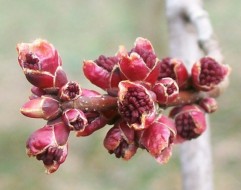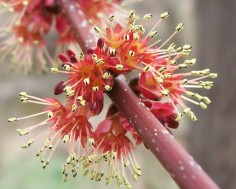Though its autumn leaves are yellow and not the commonly cited red, and though it never fruits the hallmark crimson keys we’d call “helicopters,” I can finally pin a name to the indifferent subject of my long but casual scrutiny:
a red maple tree.
Other identifying characteristics have been evident throughout the year…
I’ve gathered three-lobed leaves fallen from their opposite arrangement on summer branches, accidentally peeled plated bark from the trunk when tugging climbing ivy, collected many brittle branches dropped to the woodland floor, and patiently watched wine-red twigs and buds endure a long winter.
But it’s a small flower that finally proves the name.
In early spring, a single red maple can flower a marriage of male and female blooms, a union that will likely produce a bunch of winged seeds.
Other individuals might present exclusively male or female flowers.
The female kind may be pollinated by male neighbors and thereby fruit seeded helicopters.
But this particular red maple has revealed its own dispositon along Little Crum Creek: a naturally confirmed bachelorhood of total male florescence that won’t be going to seed.
 .
.
 Now, why its leaves turn yellow in fall, and not red, I can’t yet say.
Now, why its leaves turn yellow in fall, and not red, I can’t yet say.
.
.
.




April 5, 2011 at 7:34 am
At times Maples can experience iron chlorosis (yellowing leaves) a problem in soils with a high pH level. It can also be a matter of the tree being born from seeds, the least effective method of producing Acer rubrum. When pollinated, it can be crossed with inferior members of the species.
April 6, 2011 at 11:03 am
The spring & summer leaves are a healthy-looking green, so I don’t really suspect iron chlorosis.
I think the yellow fall color is probably some natural variation like you & Natty suggest.
Still, it would be interesting to know more about the soil that’s nurturing the nature of our maple, wouldn’t it?
April 4, 2011 at 8:16 pm
As per Michael Dirr at the University of Georgia…” The Red Maple does not always have brilliant red fall color… in the Southeast, particularly the Piedmont [we live within the Piedmont province]and Coastal Plain, Red Maple is abundant but bright red fall coloring plants are seldom evident”. I stumbled onto this two days ago searching something totally unrelated and almost jumped out of my seat, what an a-ha moment! I also read some place else the the Red-Maple name refers to the flowers, not its leaves. I am looking for additional sources to corroborate that one though.
April 4, 2011 at 8:45 pm
I love those serendipitous moments.
And thanks for bringing up the matter of “red.” I like Charles Fergus’s approach in THE TREES OF PA: “Whatever the season, red maple (Acer rubrum) shows its namesake color, vividly or with subtlety and restraint.” He then cites the redness of winter buds, spring flowers & unfurling leaves, summer leafstalks, and fall foliage.
And then I’ve seen sources allowing for orange to red coloration of autumn leaves. But yellow often seems to be treated as an exception, maybe even a deficiency(?).
April 4, 2011 at 1:11 pm
beautiful pictures!
April 4, 2011 at 8:46 pm
thanks!